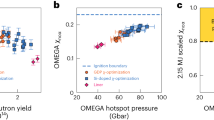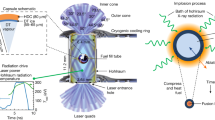Abstract
At the National Ignition Facility, inertial confinement fusion experiments aim to burn and ignite a hydrogen plasma to generate a net source of energy through the fusion of deuterium and tritium ions. The energy deposited by α-particles released from the deuterium–tritium fusion reaction plays the central role in heating the fuel to achieve a sustained thermonuclear burn. In the hydrodynamic picture, α-heating increases the temperature of the plasma, leading to increased reactivity because the mean ion kinetic energy increases. Therefore, the ion temperature is related to the mean ion kinetic energy. Here we use the moments of the neutron spectrum to study the relationship between the ion temperature (measured by the variance in the neutron kinetic energy spectrum) and the ion mean kinetic energy (measured by the shift in the mean neutron energy). We observe a departure from the relationship expected for plasmas where the ion relative kinetic energy distribution is Maxwell–Boltzmann, when the plasma begins to burn. Understanding the cause of this departure from hydrodynamic behaviour could be important for achieving robust and reproducible ignition.
This is a preview of subscription content, access via your institution
Access options
Access Nature and 54 other Nature Portfolio journals
Get Nature+, our best-value online-access subscription
$29.99 / 30 days
cancel any time
Subscribe to this journal
Receive 12 print issues and online access
$209.00 per year
only $17.42 per issue
Buy this article
- Purchase on Springer Link
- Instant access to full article PDF
Prices may be subject to local taxes which are calculated during checkout





Similar content being viewed by others
Code availability
The simulation codes used in this manuscript are not available to the general public.
References
Lindl, J. Development of the indirect drive approach to inertial confinement fusion and the target physics basis for ignition and gain. Phys. Plasmas 2, 3933–4024 (1995).
Christopherson, A. R. et al. Theory of alpha heating in inertial fusion: alpha-heating metrics and the onset of the burning-plasma regime. Phys. Plasmas 25, 072704 (2018).
Zylstra, A. B. et al. Burning plasma achieved in inertial fusion. Nature 601, 542–548 (2022).
Kritcher, A. L. et al. Design of inertial fusion implosions reaching the burning plasma regime. Nat. Phys. 18, 251–258 (2022).
Brysk, H. Fusion neutron energies and spectra. Plasma Phys. 15, 611–617 (1973).
Ballabio, L., Källane, J. & Gorini, G. Relativistic calculation of fusion product spectra for thermonuclear plasmas. Nucl. Fusion 38, 1723–1735 (1998).
Appelbe, B. & Chittenden, J. Relativistically correct DD and DT neutron spectra. High Energy Density Phys. 11, 30–35 (2014).
Munro, D. H. Interpreting inertial fusion neutron spectra. Nucl. Fusion 56, 036001 (2016).
Gamow, G. Nuclear energy sources and stellar evolution. Phys. Rev. 53, 595–604 (1938).
Moore, A. S. et al. The five line-of-sight neutron time-of-flight (nToF) suite on the National Ignition Facility (NIF). Rev. Sci. Instrum. 92, 023516 (2021).
Jarrott, L. C. et al. Thermal temperature measurements of inertial fusion implosions. Phys. Rev. Lett. 121, 085001 (2018).
Hatarik, R. et al. Analysis of the neutron time-of-flight spectra from inertial confinement fusion experiments. J. Appl. Phys. 118, 184502 (2015).
Gaffney, J. A. et al. Making inertial confinement fusion models more predictive. Phys. Plasmas 26, 082704 (2019).
Clark, D. S. et al. Three-dimensional modeling and hydrodynamic scaling of National Ignition Facility implosions. Phys. Plasmas 26, 050601 (2019).
Ross, J. S. et al. Experiments conducted in the burning plasma regime with inertial fusion implosions. Preprint at https://arxiv.org/abs/2111.04640 (2021).
Rinderknecht, H. G. et al. Azimuthal drive asymmetry in inertial confinement fusion implosions on the National Ignition Facility. Phys. Rev. Lett. 124, 145002 (2020).
Peigney, B. E., Larroche, O. & Tikhonchuk, V. Ion kinetic effects on the ignition and burn of inertial confinement fusion targets: a multi-scale approach. Phys. Plasmas 21, 122709 (2014).
Sadler, J. D. et al. Kinetic simulations of fusion ignition with hot-spot ablator mix. Phys. Rev. E 100, 033206 (2019).
Appelbe, B., Sherlock, M., El-Amiri, O., Walsh, C. & Chittenden, J. Modification of classical electron transport due to collisions between electrons and fast ions. Phys. Plasmas 26, 102704 (2019).
Sherlock, M. & Rose, S. The persistence of Maxwellian D and T distributions during burn in inertial confinement fusion. High Energy Density Phys. 5, 27–30 (2009).
Hartouni, E. P. et al. Optimal choice of multiple line-of-sight measurements determining plasma hotspot velocity at the National Ignition Facility. Rev. Sci. Instrum. 92, 023513 (2021).
Moore, A. S. et al. A fused silica Cherenkov radiator for high precision time-of-flight measurement of DT γ and neutron spectra (invited). Rev. Sci. Instrum. 89, 10I120 (2018).
Spears, B. K. et al. Mode 1 drive asymmetry in inertial confinement fusion implosions on the National Ignition Facility. Phys. Plasmas 21, 042702 (2014).
Hatarik, R. et al. A new neutron time-of-flight detector to measure the MeV neutron spectrum at the National Ignition Facility. Plasma Fusion Res. 9, 4404104 (2014).
Grim, G. P. et al. The 27.3 meter neutron time-of-flight system for the National Ignition Facility. In Penetrating Radiation Systems and Applications XIV (eds. Grim, G. P. & Barber, H. B.) 8854, 70–81 (SPIE, 2013).
Clancy, T. J. et al. Engineering architecture of the neutron time-of-flight (nToF) diagnostic suite at the National Ignition Facility. In Target Diagnostics Physics and Engineering for Inertial Confinement Fusion III (eds. Bell, P. M. & Grim, G. P.) 9211, 92110A (SPIE, 2014).
Caggiano, J. A. et al. Design of a north pole neutron time-of-flight (NTOF) system at NIF. J. Phys.: Conf. Ser. 717, 012087 (2016).
Meaney, K. D. et al. Total fusion yield measurements using deuterium–tritium gamma rays. Phys. Plasmas 28, 102702 (2021).
Crilly, A. et al. Constraints on ion velocity distributions from fusion product spectroscopy. Nucl. Fusion 62, 126015 (2022).
Acknowledgements
We would like to acknowledge many discussions with our colleagues O. Landen, P. Patel, L. Divol, P. Springer and C. Cerjan. Lawrence Livermore National Laboratory is operated by Lawrence Livermore National Security for the US Department of Energy, National Nuclear Security Administration, under contract no. DE-AC52- 07NA27344. This Article (LLNL-JRNL-824268) was prepared as an account of work sponsored by an agency of the US government. Neither the US government nor Lawrence Livermore National Security, nor any of their employees make any warranty, expressed or implied, or assume any legal liability or responsibility for the accuracy, completeness, or usefulness of any information, apparatus, product, or process disclosed, or represent that its use would not infringe privately owned rights. The views and opinions of authors expressed herein do not necessarily state or reflect those of the US government or Lawrence Livermore National Security and shall not be used for advertising or product endorsement purposes.
Author information
Authors and Affiliations
Contributions
E.P.H.: neutron diagnostics, wrote sections of paper. A.S.M.: neutron diagnostics, wrote sections of paper. A.J.C.: theory. B.D.A. theory. P.A.A.: hohlraum physics. K.L.B.: hybrid ‘shot RI’ (shot responsible individual). D.T.C.: hybrid shot RI. D.S.C.: high-resolution 3D simulations. T.D.: hybrid shot RI. M.J.E.: nToF diagnostics. J.E.F.: simulation methods. M.G.J.: neutron diagnostics. G.P.G.: neutron diagnostics development. R.H.: neutron diagnostics development and analysis code. J.J.: neutron diagnostics deployment and operations. S.M.K.: neutron diagnostics deployment and operations. J.K.: neutron diagnostics development. A.L.K.: hybrid-E design lead. K.D.M.: γ-ray diagnostics. J.L.M.: high-resolution 3D simulations. D.H.M.: theory methodology. R.C.N.: post-shot simulations. A.E.P.: hybrid and I-Raum shot RI. J.E.R.: N201101 and N210207 experimentalist and shot RI. H.F.R.: original I-Raum design lead. J.S.R.: I-Raum experimental lead and N201122 shot RI. D.J.S.: neutron diagnostics. S.M.S.: HYDRA details. B.K.S.: simulations lead. C.V.Y.: present I-Raum design lead. A.B.Z.: hybrid-E experimental lead.
Corresponding authors
Ethics declarations
Competing interests
The authors declare no competing interests.
Peer review
Peer review information
Nature Physics thanks Alessio Morace, Peter Norreys and the other, anonymous, reviewer(s) for their contribution to the peer review of this work.
Additional information
Publisher’s note Springer Nature remains neutral with regard to jurisdictional claims in published maps and institutional affiliations.
Rights and permissions
Springer Nature or its licensor (e.g. a society or other partner) holds exclusive rights to this article under a publishing agreement with the author(s) or other rightsholder(s); author self-archiving of the accepted manuscript version of this article is solely governed by the terms of such publishing agreement and applicable law.
About this article
Cite this article
Hartouni, E.P., Moore, A.S., Crilly, A.J. et al. Evidence for suprathermal ion distribution in burning plasmas. Nat. Phys. 19, 72–77 (2023). https://doi.org/10.1038/s41567-022-01809-3
Received:
Accepted:
Published:
Issue Date:
DOI: https://doi.org/10.1038/s41567-022-01809-3
This article is cited by
-
Burning plasma surprise
Nature Physics (2023)
-
Focus Fusion: Overview of Progress Towards p-B11 Fusion with the Dense Plasma Focus
Journal of Fusion Energy (2023)



